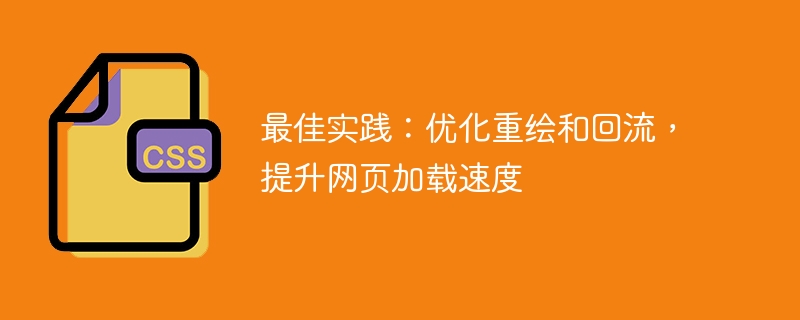

Best Practice: Optimize redrawing and reflow to improve web page loading speed
In today's era of mobile devices and high-speed Internet, the loading speed of web pages directly affects users experience and website traffic. Excessively slow loading speed will not only cause users to lose, but also reduce user satisfaction, thus affecting page ranking and conversion rate. Therefore, optimizing web page loading speed is a very important task for web developers. Among them, optimizing redrawing and reflow is the key to improving web page loading speed.
First of all, we need to understand what redraw and reflow are. Redrawing means that when the style attributes of the web page (such as background color, font color, etc.) change, the browser will redraw these elements. Reflow means that when the structural properties of the web page (such as the position and size of elements, etc.) change, the browser will recalculate the layout of the elements. Both redraw and reflow will cause the web page to be re-rendered, consuming a lot of computing resources and time during loading, thus affecting the loading speed of the web page.
So, how to optimize redraw and reflow? First of all, we can use CSS3's transform and opacity properties to achieve animation effects, instead of using top, left and other properties to change the position of elements. This is because the transform and opacity properties do not cause reflow, only redraw, thus reducing unnecessary calculations. In addition, we can combine multiple DOM operations and combine multiple redraws and reflows into one, thereby reducing the number of renderings.
Secondly, we can use throttling and anti-shake techniques to reduce the frequency of redraws and reflows. Throttling refers to reducing the number of redraws and reflows by limiting the execution frequency of callback functions, while anti-shaking avoids frequent redraws and reflows by delaying the execution of callback functions. For example, when the user types in the input box, we can use throttling technology to delay the triggering of the event, thereby reducing repeated reflows. These technologies can be implemented using JavaScript frameworks or tools, such as Lodash, RxJS, etc.
In addition, we can also reduce frequent operations on elements, thereby reducing the number of redraws and reflows. For example, when we need to change the style of an element, we can first set the element to display: none, then change the style, and finally display the element. The advantage of this is that when the element is hidden, operations on it will not cause redrawing and reflow, thus reducing the number of renderings.
Finally, we can use tools to analyze the performance and loading speed of web pages to find room for optimization. Some commonly used tools include Google Chrome’s developer tools, YSlow, WebPageTest, etc. Through these tools, we can understand the loading time of web pages, the size of resources and other information, so as to find out the factors causing slow loading speed and optimize accordingly.
To sum up, optimizing redrawing and reflow is the key to improving the loading speed of web pages. By rationally using CSS3 properties, throttling and anti-shaking technologies, reducing the number of operations, and using performance tools to analyze and optimize the performance of web pages, we can effectively improve the loading speed of web pages, improve user experience, and increase website traffic and conversion rates.
The above is the detailed content of The best way to improve web page loading speed: Optimize redraws and reflows. For more information, please follow other related articles on the PHP Chinese website!




